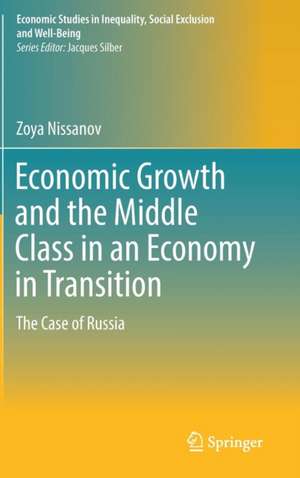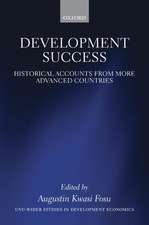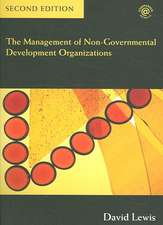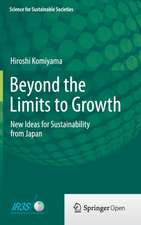Economic Growth and the Middle Class in an Economy in Transition: The Case of Russia: Economic Studies in Inequality, Social Exclusion and Well-Being
Autor Zoya Nissanoven Limba Engleză Hardback – 9 feb 2017
| Toate formatele și edițiile | Preț | Express |
|---|---|---|
| Paperback (1) | 689.14 lei 43-57 zile | |
| Springer International Publishing – 28 iul 2018 | 689.14 lei 43-57 zile | |
| Hardback (1) | 695.19 lei 43-57 zile | |
| Springer International Publishing – 9 feb 2017 | 695.19 lei 43-57 zile |
Din seria Economic Studies in Inequality, Social Exclusion and Well-Being
- 15%
 Preț: 649.22 lei
Preț: 649.22 lei -
 Preț: 419.06 lei
Preț: 419.06 lei -
 Preț: 386.00 lei
Preț: 386.00 lei - 15%
 Preț: 646.75 lei
Preț: 646.75 lei - 15%
 Preț: 637.46 lei
Preț: 637.46 lei - 15%
 Preț: 579.52 lei
Preț: 579.52 lei - 15%
 Preț: 634.18 lei
Preț: 634.18 lei - 15%
 Preț: 696.82 lei
Preț: 696.82 lei - 15%
 Preț: 641.53 lei
Preț: 641.53 lei - 18%
 Preț: 1229.40 lei
Preț: 1229.40 lei -
 Preț: 367.00 lei
Preț: 367.00 lei - 15%
 Preț: 653.98 lei
Preț: 653.98 lei - 15%
 Preț: 647.73 lei
Preț: 647.73 lei - 15%
 Preț: 640.06 lei
Preț: 640.06 lei - 18%
 Preț: 950.52 lei
Preț: 950.52 lei - 15%
 Preț: 640.06 lei
Preț: 640.06 lei - 18%
 Preț: 947.50 lei
Preț: 947.50 lei - 18%
 Preț: 949.73 lei
Preț: 949.73 lei - 15%
 Preț: 646.94 lei
Preț: 646.94 lei
Preț: 695.19 lei
Preț vechi: 817.88 lei
-15% Nou
Puncte Express: 1043
Preț estimativ în valută:
133.07€ • 144.59$ • 111.85£
133.07€ • 144.59$ • 111.85£
Carte tipărită la comandă
Livrare economică 21 aprilie-05 mai
Preluare comenzi: 021 569.72.76
Specificații
ISBN-13: 9783319510934
ISBN-10: 3319510932
Pagini: 118
Ilustrații: XVIII, 118 p. 48 illus., 29 illus. in color.
Dimensiuni: 155 x 235 x 10 mm
Greutate: 0.37 kg
Ediția:1st ed. 2017
Editura: Springer International Publishing
Colecția Springer
Seria Economic Studies in Inequality, Social Exclusion and Well-Being
Locul publicării:Cham, Switzerland
ISBN-10: 3319510932
Pagini: 118
Ilustrații: XVIII, 118 p. 48 illus., 29 illus. in color.
Dimensiuni: 155 x 235 x 10 mm
Greutate: 0.37 kg
Ediția:1st ed. 2017
Editura: Springer International Publishing
Colecția Springer
Seria Economic Studies in Inequality, Social Exclusion and Well-Being
Locul publicării:Cham, Switzerland
Cuprins
Chapter I: What does the middle class refer to?.- Chapter II: On the transition in Russia.- Chapter III: Distributional change and what happened to the middle class in Russia.- Chapter IV: Bi-polarization and the middle class in Russia.- Chapter V: On polarization in Russia.- Chapter VI: The socio-economic characteristics of the middle class.- Chapter VII: Income mobility and the middle class.- Chapter VIII: Conclusion.
Textul de pe ultima copertă
This book studies the evolution of the middle class in Russia after the fall of the Soviet Union. Using data from the RLMS (Russian Longitudinal Monitoring Survey), the volume covers the period of transition (1991-2008) during which many fundamental economic reforms were implemented. The first part of the book is devoted to a discussion of the concept of middle class and a description of the economic situation in Russia during the transition period. Particular attention is given to variations in the distribution of Russian incomes and the estimated importance of the middle class. The second part of the book focuses on the link between the middle class and income bipolarization. The third and last section of the book uses the semiparametric "mixture model" to discover how many different groups may be derived from the income distribution in Russia, as well as what the main socio-economic and demographic characteristics of those groups are. The mobility of households into and out of the middle class during the transition period is also studied in hopes of determining the factors that contribute to such mobility. Using rigorous empirical methods, this volume sheds light on a relatively unstudied economic group and provides insight for countries which are about to enter a transition period. As such, this book will be of great interest to researchers in economics and inequality as well as professionals and practitioners working with international organizations.
Caracteristici
Analyzes the evolution of the middle class in post-socialist Russia Measures of the degree of income bipolarization in Russia during a sixteen year period of economic transition Uses semiparametric methods to determine the characteristics of economic classes in Russia as well as the likelihood of movement between them Includes supplementary material: sn.pub/extras














